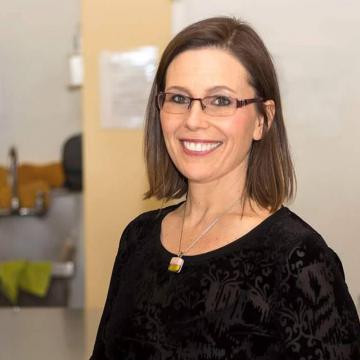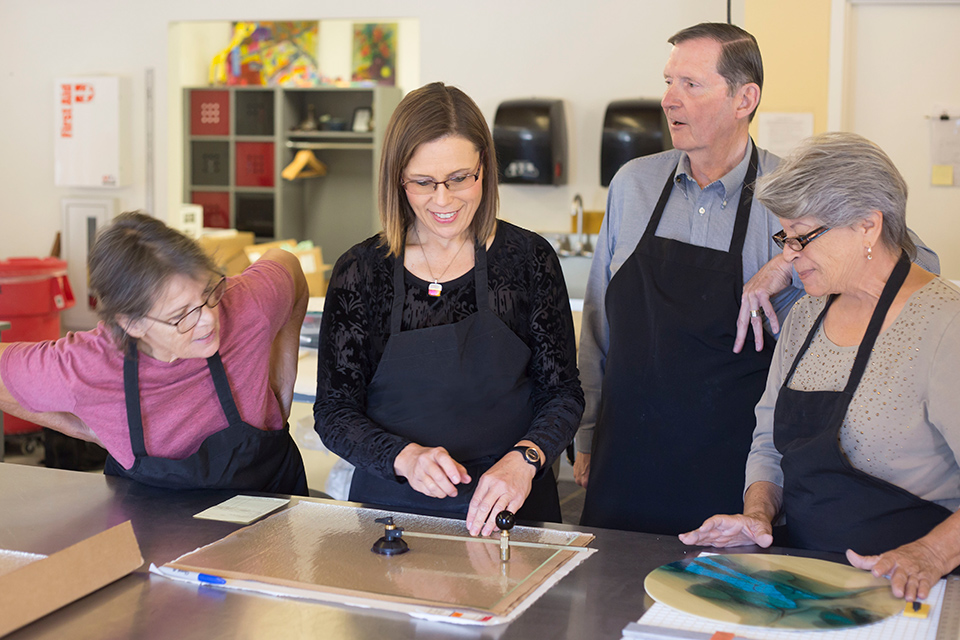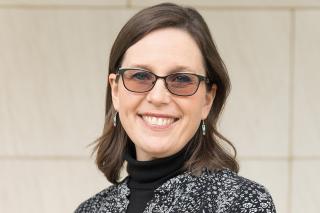Abhilasha Natarajan '22 is a double major in social work and fine arts. After teaching fused glass in Tracy, California for 17 years, she relocated to Boston in 2019 with her spouse and their three children. In January 2020, Abhilasha enrolled as a Dix Scholar to complete her bachelor’s degree, which she started in Canada over 25 years earlier. Abhilasha plans to continue with her master’s in social work next fall as well as develop her studio art and give workshops within her community.
Natarajan is the creative vision behind “Re-assembling” and “Bound Together.” Both exhibits are currently on display in the Management and Academic Building (4th floor) and the Main College Building (4th floor). Learn more about her journey.
Tell us a little about your background as an artist.

I cannot remember a time when art was not part of my life. One of the memories I have growing up is of my maternal grandmother asking me to pose as she created a small bust of my head. She was a potter, painter, printmaker, and high school art instructor. One of the phrases she used that stuck with me over the years was “I wonder what would happen if we….” The creative investigation was on.
Roughly 21 years ago, my mother, who is also an artist, and I took a class in warm glass. That set my course for the next 20 years working and teaching primarily in glass. I was very involved in the art community where I lived before I moved to Boston.
What inspired you to change career paths and pursue a bachelor of social work (BSW)?
My family and I moved to Boston two and a half years ago. This allowed me the opportunity to return to school full-time. There are several reasons why I am choosing a career in social work. First, at a time in my life when I felt like I had run out of answers, a social worker, in the role of psychotherapist, gave me emotional support in such a way as to change the course of my life. I am deeply inspired to offer similar support to others.
Also, I like people. I like working with people. I’m very curious about the stories that each person has to tell. I’m interested in knowing where a person has come from, where they are now, and where they’re headed. I believe in each person’s ability to overcome challenges. Most of us, however, at one time or another, face seemingly insurmountable challenges. Those are the times when we most need someone to talk to; someone to walk alongside us on our journey. I want to be there for that.
I’m loving the chance to work as an intern while learning social work skills at Simmons. I have had the good fortune to work with clients one-on-one, lead a group and help write a grant. I’m so grateful to have such an integrated approach to learning with both classroom time and practice in the field. Simmons has an amazing social work program and I’m so grateful to be part of it.
Simmons has an amazing social work program and I’m so grateful to be part of it.
What were you looking for during your college search process?
I wanted a college that had a strong clinically-based social work program. I was looking for a college that was in Boston, accessible by public transportation. I was excited about Simmons as a women-centered school, and that it had a small, community feel. I loved the idea of going to the school that one of my very best friends, Susan, graduated from nearly 50 years ago (Simmons), and her mother before her. And I was over-the-moon excited that Simmons was part of the Colleges of the Fenway, which included MassArt. If I could have taken simultaneous degrees at both Simmons and MassArt I probably would have.
How do art and social work intersect?
Contemporary art is very involved in issues of identity, social change, and social justice. Many contemporary artists use their work as a platform to raise awareness about oppression, racism, sexism and environmentalism. The practice of social work can be a direct and practical way to help those dealing with issues of identity and social injustice. Additionally, social work sometimes uses various forms of creative arts in the therapeutic process. Social work and art intersect often, but I feel that it is okay to hold them as parallel journeys.

Tell us about preparing for the exhibit.
Professor Helen Popinchalk mentored me through a deeply personal creative exploration to find joy and spaciousness in a time of societal grief and confinement. Assembling mixed media became a tether between my inner world and something tangible. For an intensive six weeks, she coached me through working with collage, abstract painting, neurographic art, texture, stamp making, stencil making, watercolor, mixed media and a continuation of the bookmaking from the previous semester.
When Professor Popinchalk proposed an opportunity to exhibit on campus, I said “Yes!” She has since guided me through the process of hanging the show and we are now making plans for the hybrid artist’s talk.
In reflecting on the work as I prepared to display it publicly, I found that the process of assembling the art, individually and collectively mirrored, in some ways, our re-integration onto campus. I feel that we have begun a time of transition. We are re-connecting from spaces of isolation and privacy to social in-person interactions.
I also reflected on the relationship between the books and our commitment to this academic journey. There is an invisible thread that binds us together as staff, students, and alumnae/i within the pages of our Simmons story, even when we were not together in person.
I’m very grateful to Colleen Kiely and the Art Department for encouraging me to do this independent study. I would also like to thank the Office of Research and Fellowships for their generous support for this project from the Undergraduate Research and Creative Endeavors Fund. And I’m deeply indebted to my hero, Professor Helen Popinchalk, for the unwavering support, encouragement, and resourcefulness throughout the process of art-making as well as for the opportunity to exhibit this work. This has been a tremendous experience of learning and growth for me.
This has been a tremendous experience of learning and growth for me.
Do you have any tips for those considering changing career paths like yourself?
This is going to sound corny but, honestly, follow your heart. I was in a ceramics class in California at a community college about 15 years ago and a fellow student asked me what I wanted to study. My answer was fine arts and social work. His answer derailed me for several years. He said, “Oh great! Two subjects that don’t earn any money!” At that time I reevaluated my plan. I wondered if I was being foolish to spend so much time and energy, especially so late in life, getting degrees in things that wouldn’t pay. My head was confused but my heart was very clear. This has been my career path for a long time. What looks like a change externally, is really a fulfillment of the educational journey I have been on for a long time.
How is Simmons preparing you to become an everyday leader?
Simmons has given me a new perspective on what a leader looks like. The type of leader I hope to be is one who practices cultural humility, one who listens to others and collaborates with people in her community. I want to be the type of person who reflects deeply about her own privileges, values and biases.
I hope to be an everyday leader who inspires others, advocates for individuals and helps to fight systemic battles of oppression and brings about greater equity and inclusion. I hope to be the type of leader that practices good self-care, because I have invested a lot of time, work and resources in the person I have become and that investment is worth taking care of.

